There is nothing new in seeing an organization or product being endorsed by a professional athlete. Sports stars have done that for years and the association with athletes is usually a good ‘add on’ for the organization or product. The business of sports is a celebrity-driven culture so this association enhances recognition and a positive brand transfer between the involved parties’ values, e.g. credibility, quality, or coolness.
The corporate sector normally applies sports stars as spokespersons, opinion leaders or brand ambassadors and have them promote the corporate brand via real life appearances, or when wearing the corporate brand’s logo or consuming its products via television activation. Having said that, it is important to note that ‘time and context’ are vital parameters in the brand management and brand-building processes. Sports branding is no different. On the other hand, it may be different in the sense that sport is an industry (like music) that is differentiated in terms of its consumption patterns in cyberspace. In terms of ‘time and context’, societal trends show that sports consumption grows and so does the amount of sports fans turning to Internet-driven sports consumption, see tables below.
Table 1 depicts devices used to access sports content online, Table 2 depicts frequency of accessing sports content online, Table 3 depicts methods that sports fans use to catch up with sports news stories, Table 4 depicts the hours spent per week consuming sport. Source: ‘knowthefan‘, The Global Sports Media Consumption Report 2014.
With these trends, sports sponsorship models are influenced. Sports sponsorship will keep blooming for some of the reasons mentioned above but the demand for digital sponsorship solutions will increase intensively due to this development. The restrictions of the traditional sports sponsorship model are opening up with the opportunity of engaging professional athletes in digital solutions.
Infographic: Sports media consumption in the US, 2013 (source: AdWeek. Sports image via Shutterstock.)
On top of sponsors requiring sports stars to participate in specific events, not to use a competing sponsor’s products and so on, the smart sponsors inspire (or even include it in the sponsorship contracts) athletes to engage in digital and social media initiatives as part of the sponsorship deals. ‘Tweeting’, ‘re-tweeting’, endorsing videos on Facebook or hosting ‘Google+ hangouts’ involving the sponsor’s brand are actions in high demand by sponsors. The online environment surrounding professional athletes certainly has the ability to move market shares and when athletes are posting endorsing videos on Facebook, it marks a powerful sponsorship activation tool.
Looking at the tables above, it is evident that the growth of social media and hence digital sponsorship solutions outdate the current sports sponsorship models. Social media goes behind the curtains and provides access into the lives of popular sports stars in ways that used to be inaccessible to fans. Accessibility is a significant brand-building tool and this opportunity of getting insights into the ‘real’ athlete offers fans a welcoming and more sociable perception of the athlete. The sports stars may be perceived as being more approachable and down-to-earth through these new sponsorship channels instead of being associated with the traditional and ‘colder’ production sets.
Photo: LeBron James endorsing Nike products via Twitter
At the same time, the sports star’s authenticity is boosted as fans are fully aware that sports stars (in real life) are not restricted to one soft drink brand in their home or one shampoo or fragrance brand. So, these new digital endorsement solutions provide sponsors with the opportunity to have their brands endorsed without the need of ‘too much’ exclusivity. In relation to big endorsement deals, compliance with digital activities is most often a ‘must’ but as the demand for digital solutions grow, it must be detached from traditional endorsement deals in some cases. In this sense, authenticity in its finest version comes when an athlete wears a sponsored product, includes the logo on the podium and sticks with it in real life because he/she wants to while sharing these stories online. The point is that it is rare that you see champions wearing products solely from digital endorsement deals. Traditional sponsorship deals require exclusivity for a reason, i.e. Nike would not like to see Cristiano Ronaldo wear Adidas gear during a press conference. That’s how it is when working with top professional athletes. However, digital sponsorship deals are distinctive and they act as product placement opportunities within a social media feed, which strengthens the sponsor’s product or brand on the human side of sports. The latter refers to the side that highlights the everyday choices and lifestyle that anthropomorphize professional athletes in front of their fans. This explains why the new version of digital social sponsorship deals are (or will be) in high-demand.
Photo: Cristiano Ronaldo endorsing his CR7 underwear via Twitter
Examples of digital content related to sports sponsorship, see videos below:
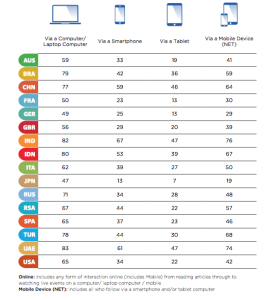
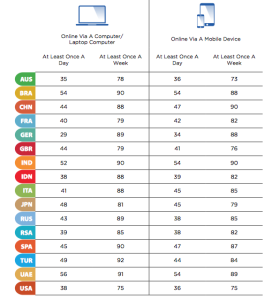
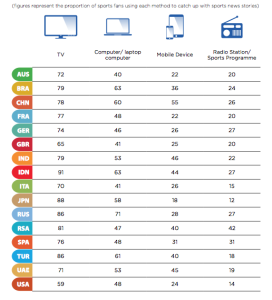
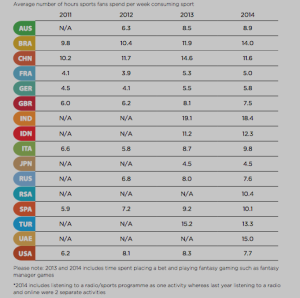

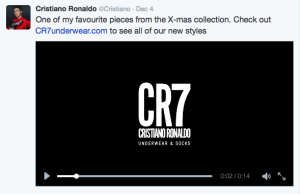
COMMENTS
No comments yet.